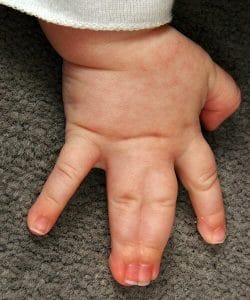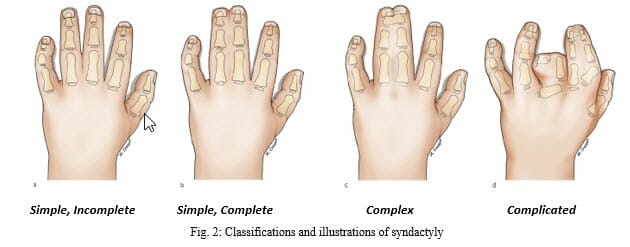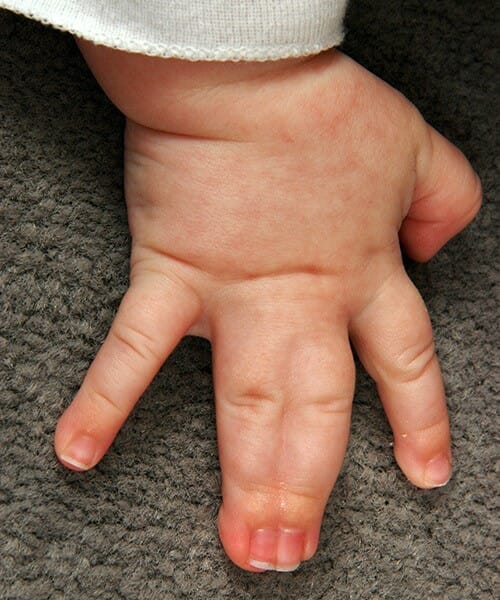Syndactyly
Patient Education Leaflet
Overview
Syndactyly is a congenital deformity that causes two or more fingers or toes to be joined or webbed together. This is a fairly common condition that affects 1 out of every 2,500 newborns. The only treatment for it is surgery to separate each digit and reconstruct the surrounding skin. For the purpose of your office visit with Dr. Tran, a hand specialist, we will discuss syndactyly of the fingers.
 Fig. 1: Complete syndactyly of the 3rd and 4th digit in a 1-year old child.
Fig. 1: Complete syndactyly of the 3rd and 4th digit in a 1-year old child.
Description
Syndactyly can involve webbing of any two or more fingers. The degree of conjoin varies in each patient as classified in correspond to its complexity.
Syndactyly Classifications
-
- Incomplete: the joining between digits does not extend all the way to the fingertips
- Complete: the joining extend all the way to the fingertips
- Simple: the fingers are joined only by soft tissues
- Complex: the fingers are joined by soft tissues and bone or bony cartilage in a side-by-side fashion.
- Complicated: the fingers are joined by soft tissues and bone or bony cartilage with abnormal shape, extra or missing bones.

Cause
The direct cause of syndactyly is unknown. What is known is that the formation of the arm occurs between 4 to 8 weeks of gestation. Initially, all the fingers are webbed together, and become separated by the 56th day. However, if the cell signaling does not occur, the skin stay webbed to what we know as syndactyly.
In most cases, there is nothing parents can do to cause or prevent syndactyly as it occurs in isolation and sporadically. On the other hand, there are about 10 to 40 percent of cases where the condition is inherited genetically. Syndactyly can also be a symptom of a genetic syndrome, such as Poland syndrome, Apert Syndrome, or Holt-Oram syndrome.
Symptoms
The severity of symptoms can vary with different classifications of syndactyly. Typically, most children function well with simple syndactyly. However, if more fingers are affected, it can be more difficult to grab large or circular objects as the fingers do not spread apart as far as they should. Complete, complex or complicated syndactyly can also interfere with the growth of the affected fingers and their functions. The hand also looks different, which may lead to stress and decreased self-esteem in the child.
Doctor Examination
Syndactyly is visible at birth. The condition may so be diagnosed early in utero by fetal ultrasound. Your doctor will also order an x-rays to access the underlying bone structure of the hand.
Treatment
The treatment for syndactyly includes surgery and follow-up therapy. Surgery is often performed when the child is between 1 to 2 years old. During the operation, the hand surgeon will surgically release the fingers from their webbing with z-plasty. This is a technique where the incision is made in a zig-zag pattern to divide the skin evenly between two fingers. Some cases may require skin graft taken from another part of the body. To prevent complications with the skin coverage and blood supply to the treated fingers, surgery is performed to separate two fingers at a time. If the child has multiple fingers webbed, more surgeries will be required to completely separate all affected fingers.
After surgery, the child will be placed in an above-elbow cast for three weeks to help immobilize the hand while it heals. Once the cast is removed, the hand surgeon will have your child wear a splint that slides in between the fingers to keep them apart for another six weeks. During this time, hand therapy is recommended to optimize healing and function recovery.
 Fig.3: Syndactyly release surgery with z-plasty technique.
Fig.3: Syndactyly release surgery with z-plasty technique.
Outcomes
Most young patients gain adequate finger function and improved appearance of their hands after surgery. Hand therapy can help minimize stiffness, scarring and swelling as well as improving function. Your child will need to follow up with the hand surgeon for a number of months or years to ensure adequate healing and assess if further surgery is need to improve the appearance of the hand as the child grows.
References:
Boston Children’s Hospital. (2020). Conditions: Syndactyly. Retrieved from http://www.childrenshospital.org/conditions-and-treatments/conditions/s/syndactyly
Boston Children’s Hospital. (2020). Syndactyly: Diagnosis & treatment. Retrieved from http://www.childrenshospital.org/conditions-and-treatments/conditions/s/syndactyly/diagnosis-and-treatment#:~:text=How%20is%20syndactyly%20diagnosed%3F,determine%20a%20course%20of%20treatment.
Kvemmo, H. (2013). Figure 3: Treatment of congenital syndactyly of the fingers. Retrieved from https://www.researchgate.net/figure/Example-of-a-plasty-for-separation-of-syndactyly-between-the-long-and-ring-finger-a_fig3_256083902
Kyemmo, H. (2013). Figure 3: Treatment of congenital syndactyly of the fingers. Retrieved from https://www.researchgate.net/figure/Classification-of-syndactyly-Syndactyly-between-long-and-ring-finger-a-Simple_fig2_256083902/actions#reference
Washington University Physicians. (2017). Syndactyly. Retrieved from https://www.ortho.wustl.edu/content/Patient-Care/3221/Services/Hand-Microsurgery/Overview/Congenital-Hand-Disorders/Syndactyly.aspx


